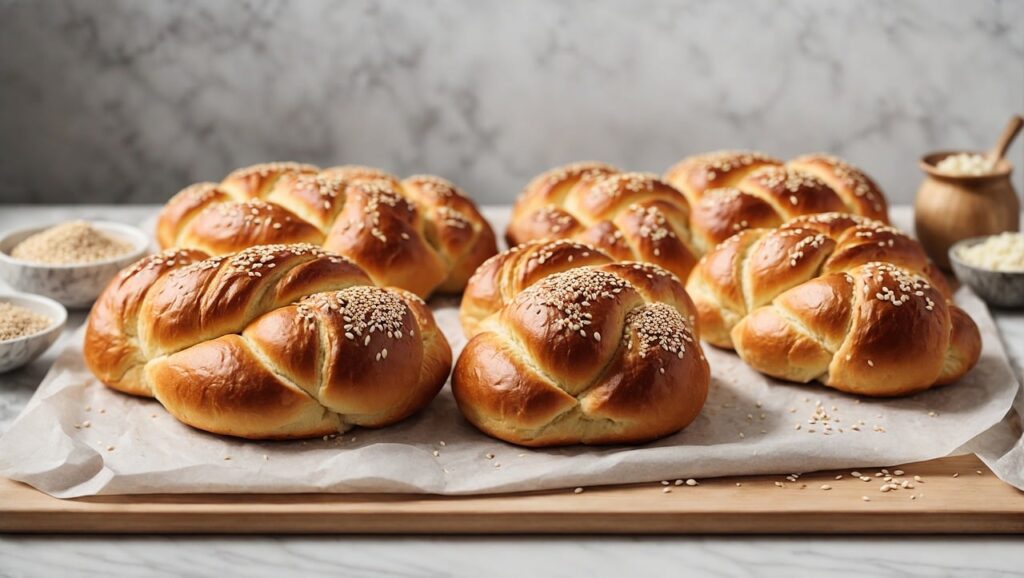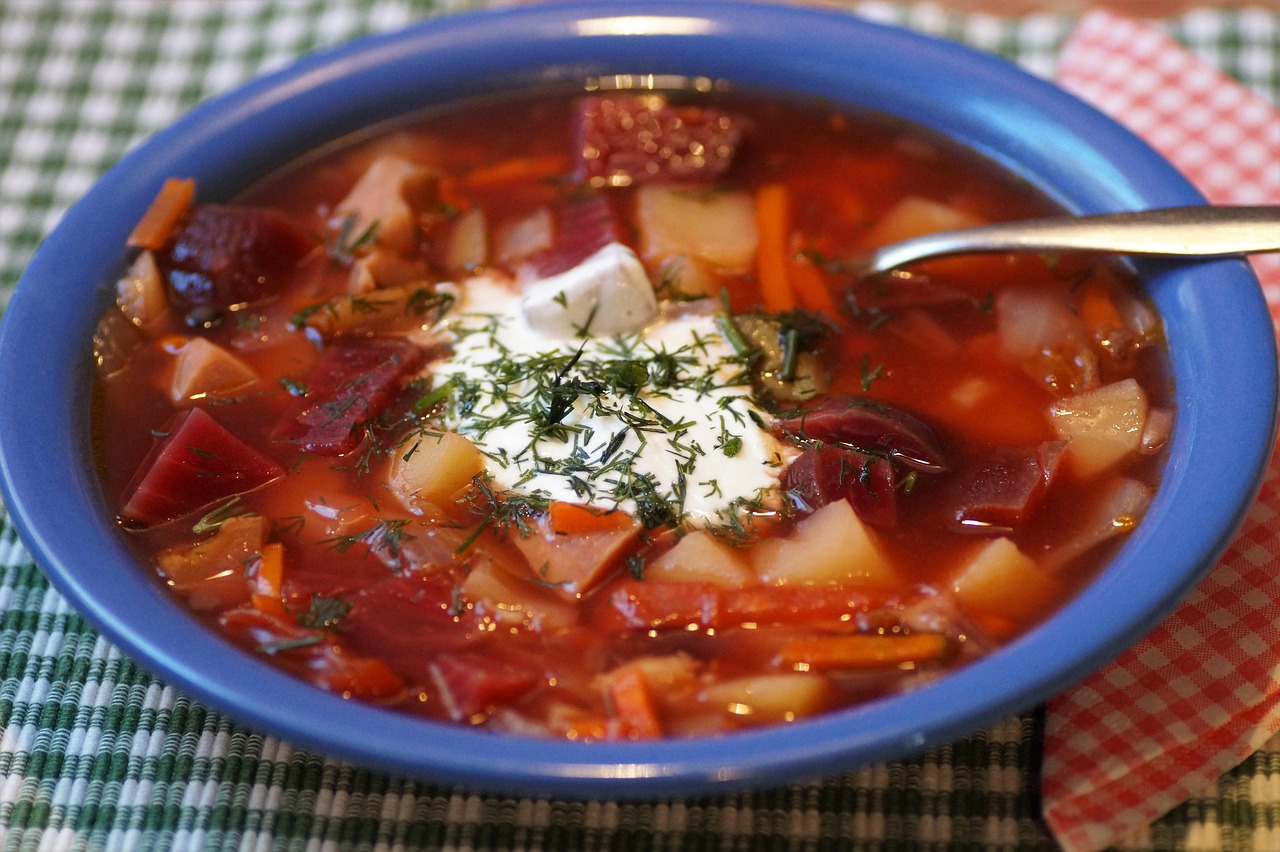When I was three years old, my new-immigrant parents and I lived above a Jewish bakery. So, while all find the smell of baking bread evocative, it is particularly so for me.
Today, notwithstanding the fact that the best kosher bakery in my area is located just down the street from where I live, my family wouldn’t consider it Rosh Hashanah without the apple challah which I adapted from a recipe by Zillah Bachar in the Jewish Bulletin of Northern California. [One year, I had become so confident about baking challah that I even came up with a special one to eat in the sukkah: I cut out a freeform pomegranate from a small portion of dough and arranged it across the top of the round challah. The bas relief of the form was enhanced by the fact that I applied egg wash only to the pomegranate.]
Apple Challah
Makes 1 large or 2 medium loaves, 20 slices
Bread:
1 cup warm water (110 F)
1 tsp. sugar plus 1/2 cup sugar
4 tsp. dry yeast [40 grams of fresh; or 4 tablespoons of Shimrit, an Israeli product]
2 eggs, room temperature
1-1/2 tsp. vanilla
2-1/2 tsp. salt, preferably kosher[ing]
1/4 tsp. cinnamon
1/2 cup oil (or melted, unsalted butter)
5 to 6 cups, approximately, bread flour or unbleached all-purpose flour
1 cup warm water (110 F)
1 tsp. sugar plus 1/2 cup sugar
4 tsp. dry yeast [40 grams of fresh; or 4 tablespoons of Shimrit, an Israeli product]
2 eggs, room temperature
1-1/2 tsp. vanilla
2-1/2 tsp. salt, preferably kosher[ing]
1/4 tsp. cinnamon
1/2 cup oil (or melted, unsalted butter)
5 to 6 cups, approximately, bread flour or unbleached all-purpose flour
Egg wash:
1 egg
1 egg yolk
1 egg
1 egg yolk
Apple filling:
3 cups coarsely chopped apples, peeled or not (2 to 3 large apples)
1/2 cup white sugar
1 tsp. cinnamon
3 cups coarsely chopped apples, peeled or not (2 to 3 large apples)
1/2 cup white sugar
1 tsp. cinnamon
Topping:
2 to 3 tbsp. sugar for sprinkling
2 to 3 tbsp. sugar for sprinkling
In a large mixing bowl, stir together the warm water, the teaspoon of sugar and the yeast. Let stand 2 to 3 minutes to expand yeast.
Briskly stir in the remaining 1/2 cup of sugar, the eggs, vanilla, salt, cinnamon and oil (or melted butter). Add in most of the flour to form a soft dough. Knead eight to 10 minutes to make a smooth dough, adding more flour as needed (the end result will still be slightly sticky). Place in a lightly oiled bowl and cover with a slightly damp tea towel and let rest until doubled, about one hour.
Prepare egg wash by whisking together the whole egg and egg yolk. Preheat oven to 350 F. Spray a 10-inch springform pan (for Shabbat: a 12-by-5-inch loaf pan, 12-cup tube pan, bundt, or two 8-1/2-by-4-1/2-inch pans) generously with non-stick cooking spray.
Meanwhile, prepare the apples. Try Golden Delicious or MacIntosh, depending on your family’s tastes. Place in a medium-sized bowl and toss with sugar and cinnamon.
Turn dough out onto a lightly floured board. Roll or pat out into a large round (about 10 inches across). Press in half of the apples. Fold the dough over to cover apples and press to seal. Flatten dough slightly and press in remaining apples, folding dough over apples, and pressing in any apples that may pop out (just put them back or stick them on top of the dough later). Don’t worry if apples and sugar start oozing out – it works out in the end. Let dough rest 5 minutes on the work surface.
Using a sharp knife, cut into 16 chunks. Lay the chunks of apple-filled dough in prepared pan, lining bottom first, then gently laying remaining pieces on top. Top with any escaped apple pieces.
Dab on egg wash as thoroughly and generously as possible (since dough is not a smooth surface, you have to drizzle and dab on the glaze, rather than paint it on). Sprinkle with sugar. Cover loaf pan lightly with damp tea towel.
Let rise until doubled or until loaf is almost flush with the top of the pan, about 1 to 2 hours, depending on weather and dough’s inclinations.
Bake 42 to 45 minutes in the springform, large loaf pan or tube pan, 35 to 40 for the smaller loaf pan. Cool in pan 10 minutes before removing and cooling on a rack.
Leftovers [rare] make irresistible French toast.
***
A Jewish “foodie” on the web who goes by the name The Old Bear [his Hebrew name is Dov] is the challah baker in his family. He offers this recipe and braiding technique which also can be used for Shabbat: <http://www.arctos.com/challah/>.
***
When automatic bread makers (ABMs) made the scene, Elaine Radis, of Framingham, Massachusetts, was quick to adopt the appliance to handle the labor-intensive mixing and kneeding stages. After the dough has risen in the ABM, it’s removed, shaped by hand, and baked in the oven.
Elaine, whom some of her friends call “Techno Bubbie” (and never travels without her schlepptop computer or digital camera), created a digital cookbook for her children and grandchildren which includes this challah recipe.
Elaine’s Bread-Machine Challah
1 package yeast
3 cups flour
4 tablespoons sugar
2 eggs
6 tablespoons vegetable oil
1-1/2 teaspoons salt
3/4 cups warm water
3 cups flour
4 tablespoons sugar
2 eggs
6 tablespoons vegetable oil
1-1/2 teaspoons salt
3/4 cups warm water
-
Combine all ingredients in the pan in the order listed and select white bread; push start If you don’t have a DAK follow the directions for your own machine. You can bake it in your machine OR follow the directions below.
-
When we make this into challah, we remove it from the breadmaker after the manual mode stops, (second rise); and then braid and rise again; then put an egg wash over the challah.
-
EGG WASH: One egg beaten with an equal amount of water. Brush on liberally BEFORE baking and then once during the bake. It makes the challah have a hard and shiny crust. BEAUTIFUL. You can sprinkle on seeds of your choice (sesame or poppy) after the first ‘wash’.
-
BAKE in a 350 degree oven until a light toasty brown.
NOTE: When I serve this challah to company they have a hard time believing that it comes out of our oven.
SOURCE: A Jewish Mother’s Cookbook; Author, Elaine Radis; published on disk by ONE COMMAND SOFTWARE, 1995.













